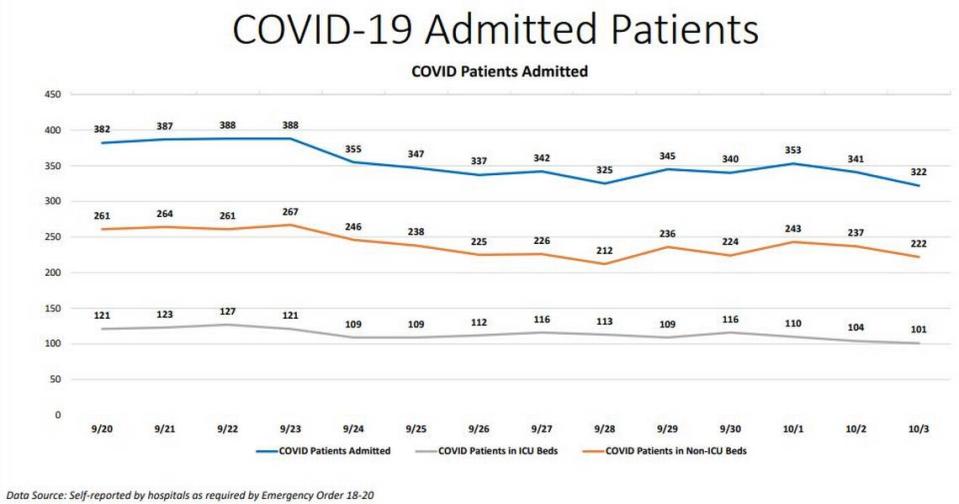Florida reports 2,787 new COVID-19 cases and, breaking a trend, under 100 deaths
UPDATE NOTE: This cases and deaths reported were changed from an earlier version after the state of Florida’s COVID-19 dashboard updated. This keeps the source of the statistics reported in Herald stories day-to-day would remain consistent.
The state of Florida’s COVID-19 dashboard reported 2,787 new COVID-19 cases and 74 deaths Saturday, breaking a run of four consecutive days with a death count of over 100.
After 99 deaths were reported on Tuesday, Sept. 22, eight of the next 10 days reported death tolls of over 100. The two that didn’t were last Sunday and Monday, days of the week when cases and deaths reported often are lower because less data gets entered over the weekend.
For the pandemic, Florida has had 714,591 cases, 14,628 resident deaths and 14,803 total deaths.
South Florida counties
▪ Miami-Dade reported 485 new cases and 16 new deaths for pandemic totals of 171,876 total cases and 3,330 resident deaths, respectively. According to the state’s county-by-county breakdown, The average daily positive rate for the previous seven days was 4.97%, still under 5% but up from 4.67% average of the previous seven days. Also, the last three days have been above 5%.
▪ Broward County’s 131 new cases leave it at 77,762 total cases. The dashboard reported one fewer death than it did Friday, 1,415 to 1,414 deaths. The county also continued keeping its positive test rates low, with five days under 3%, one of which was under 2%.
▪ Palm Beach had 129 new cases, a pandemic total of 46,962, and two deaths, moving the death toll to 1,391. Nine of the last 14 days, Palm Beach’s positive test rate has been under 4%.
▪ Monroe County added five new cases and no deaths. The Keys have had 1,861 cases and 22 deaths.
6 hand sanitizers for kids recalled. There’s a reason kids might eat or drink them
Current Hospitalizations
Government officials use current hospitalizations to decide the next action in dealing with the pandemic. On the state level, this has been steadily falling over the last month.
The Florida Agency for Health Care Administration reports the number of patients hospitalized statewide with a “primary diagnosis of COVID.” The data, which is updated at least every hour, does not distinguish between the number of COVID-19 patients in hospital intensive care units and those in acute-care beds, which require less attention from nurses.
As of 1:06 pm. Saturday, the AHCA’s said there were 2,036 people currently hospitalized, down 18 from Friday evening. Miami-Dade was down 15 to 262; Palm Beach was down six to 99; and Monroe was down two to four. Broward was up three to 207.
Florida’s current hospitalization data does not always match the hospitalization data reported in Miami-Dade’s New Normal Dashboard. Officials say this could be for a number of reasons, including the frequency of daily updates.
Saturday, Miami-Dade reported 322 people current hospitalized from COVID-19 and 101 COVID-19 patients in Intensive Care Unit beds.

Testing
The state reported another 24,945 people have been tested, a total of 5,383,648 during the pandemic. The positive test rate for the pandemic is 13.27%.
By the state’s numbers, it’s average daily positive test rate for the last seven days is 4.48%, a baby slide from 4.69% for the previous seven days.

Johns Hopkins University’s Coronavirus Resource Center agrees with the state on the overall pandemic positive test rate percentages, but differs with the state on the daily, weekly and monthly percentages. It states Florida’s positive test rate over the week before Friday was 10.94%.
Johns Hopkins’ site explains how it calculates positive testing rate for each state: “Our calculation...looks at number of cases divided by number of negative tests plus number of cases.
We feel that the ideal way to calculate positivity would be number of people who test positive divided by number of people who are tested. We feel this is currently the best way to track positivity because some states include in their testing totals duplicative tests obtained in succession on the same individual, as well as unrelated antibody tests.
“However, many states are unable to track number of people tested, so they only track number of tests. Because states do not all publish number of positive and number of negative tests per day, we have no choice but to calculate positivity via our approach.”
Florida says it figures positive test rate by calculating “the number of people who test positive for the first time divided by all the people tested that day, excluding people who have previously tested positive.”

